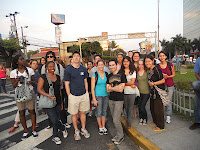Thursday was one of my favorite days of the weeklong experience. We’d spent a packed Wednesday night speaking with our host brother, mother and sister, and learning a Ballet Folklorico dance for the entertainment of what seemed like the entire village of Colonia Redondel. The day began bright and early at our host family’s house. Though I am definitely not a morning person, at this point in our trip it was surprisingly easy to wake up to the chorus of roosters crowing outside our room at 5:45 AM, especially knowing that our Salvadoran friends had been up for hours already. Despite some fleeting trepidation, I found the process of taking the shower outdoors, using a bucket of water as the source of shower water, was not only an enjoyable process, but it also put our own wasteful and comparatively extravagant comforts into perspective. After a delicious breakfast and another long talk with our host family, we were all picked up from our host families. It was truly eye opening to put faces to the horrific war stories we had already heard of from past speakers, but it was even more poignant to see that despite all their hardships, the people that we met were genuinely happy and hopeful. The newly reunited delegation shared our wonderful experiences on the way to our next stop, the Casa Comunitaria in Cacaopera.
 |
| Miguel Angel Amaya y Amayo |
One of the things that really stood out for me when I compared El Salvador with my time spent in Guatemala was that I did not see anyone wearing traditional or indigenous dress. In Guatemala, though the indigenous communities face an uphill battle against extreme racism and discrimination, they have been able to reclaim their indigenous dress, languages and customs. In contrast, Miguel Angel Amaya y Amayo told us that not only does the government not recognize indigenous identity, but that indigenous themselves have rejected the dress, customs and even the label of indigenous as well. Miguel Angel Amaya has faced an uphill battle to gain rights and recognition. He told us about his incredible attempt to save the basically extinct language of Cacaohuera, resurrecting 3000 words from the memory of 15 ancianos (elderly) who themselves referred to it as the “devil’s language.” He taught us a few phrases, such as “Warakalan, Sajuwin” or “Light in the mind and peace in the heart,” and an embrace: “en la kech” and “ah la ken,” or “you are my other me and without you I cannot live.” It was really inspirational to hear his efforts to save the indigenous identity, and how we can really bring attention to this issue. Our attention and awareness of this issue can really help in this case. I am really interested in issues of indigenous identity and discrimination in wartime and its aftermath, and I was very moved by this talk.
 |
| Anais Berland & Kia Thorn at the Rio Sapo |
After our lunch at the Church and a goodbye to the Catholic Community, our much smaller delegation departed for Rio Sapo to have some fun camping and swimming with some of the young members of the OSCA youth group, including my host brother Leonidas. Our Liberation class took over some tents in honor of Kiah’s first time camping and after quickly changing into shirts and shorts to swim in. After a beautiful afternoon splashing in the rock-lined river, we had a delicious dinner complete with lightening and icebreaker games with the Salvadoran kids. After dinner, we finished the day with a bonfire talk with a former guerilla fighter and child soldier, and then headed to bed in our cozy tents.
The time we spent in the country was very different from our time in the city, but really gave us an opportunity to get a better feel for ordinary life in the country. It felt very organic to spend this time in Morazán. After studying genocide and mass atrocity issues, it was so wonderful to see all the optimism that still exists, even in the harsh realities left in the aftermath of the Civil War.
Anais Berland














